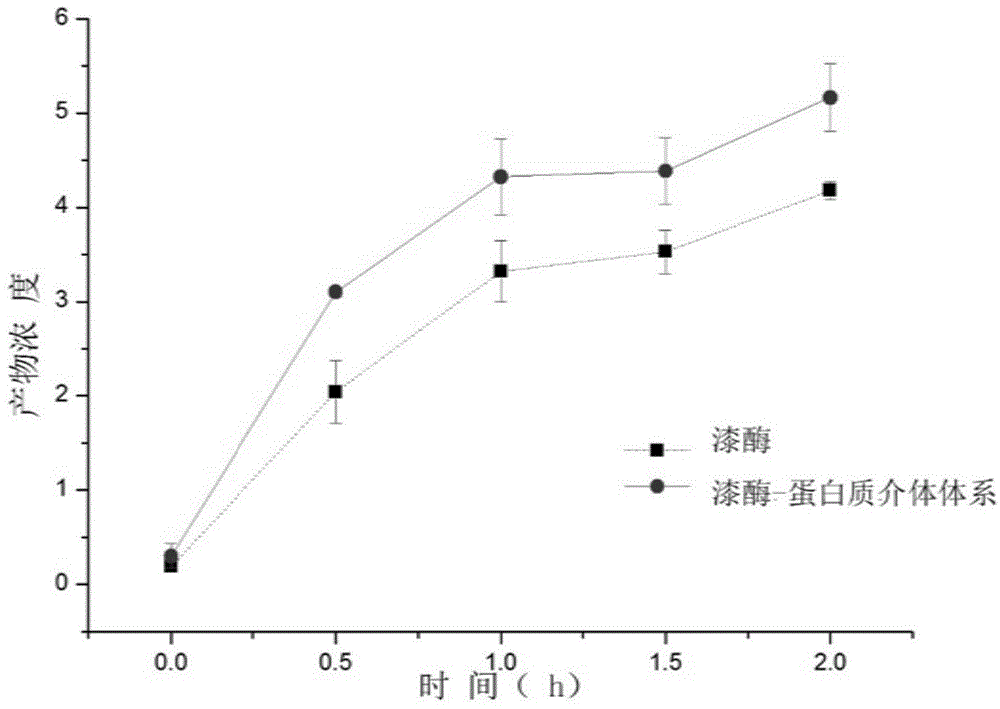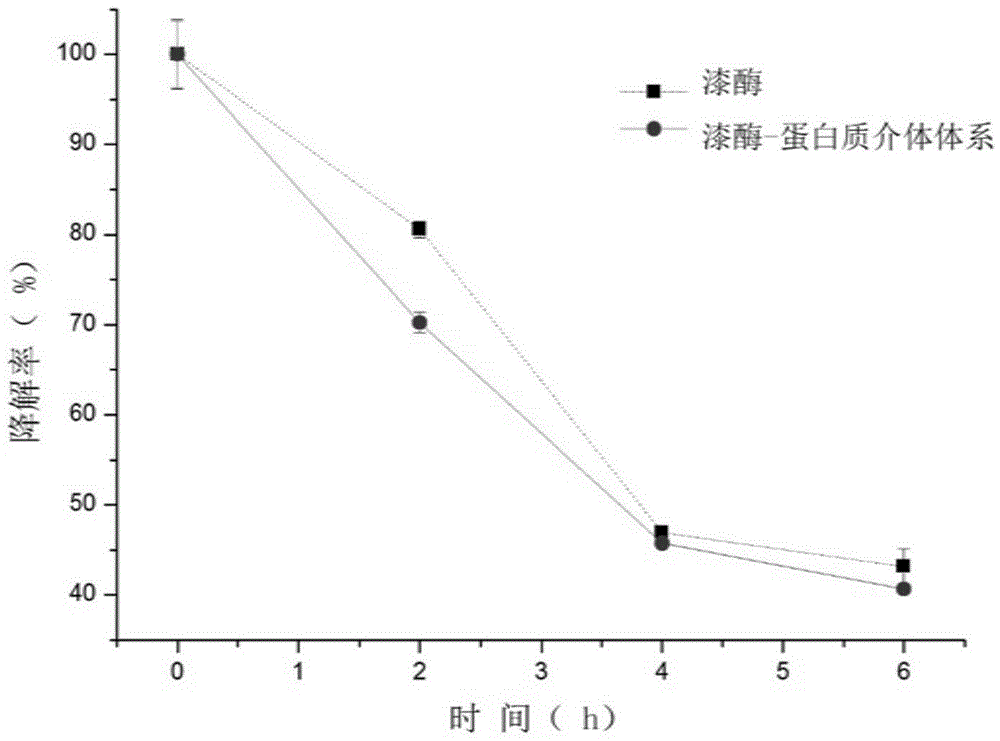Method for treatment of water pollutants by protein mediator based immobilized laccase
A technology for immobilizing laccase and water treatment, applied in water pollutants, chemical instruments and methods, biological water/sewage treatment, etc., can solve the problems of high cost and unstable use properties, and achieve low cost, easy operation, The effect of shortening the reaction time
- Summary
- Abstract
- Description
- Claims
- Application Information
AI Technical Summary
Problems solved by technology
Method used
Image
Examples
Embodiment 1
[0030] Preparation of immobilized laccase
[0031] Step 1: Weigh 2g of sodium alginate, add water to 100mL, and heat until completely dissolved.
[0032] Step 2: After cooling, add a certain amount of laccase and hemoglobin, and stir for 5 minutes to make it uniform.
[0033] The laccase is white rot fungus (T. versicolor) laccase, purchased from Sigma-Aldrich Company.
[0034] Step 3: Use a syringe to drop the above liquid into 0.05mol / L CuSO 4 In the solution, let stand at room temperature for 0.5h until it solidifies completely.
[0035] Step 4: Wash the prepared immobilized enzyme repeatedly with distilled water until no blue precipitate is produced after adding NaOH to the washing solution. The prepared immobilized laccase is light blue-green spheres with a diameter of about 2mm and a weight of about 12.5mg.
Embodiment 2
[0037] Activity determination of immobilized laccase
[0038] The o-tolidine solution was chosen as the substrate for the determination of immobilized laccase activity.
[0039] Step 1: Measure 150mL of concentrated hydrochloric acid and dilute to 500mL with distilled water. Weigh 1.00 g o-tolidine, and suck 5 mL of the prepared hydrochloric acid into a glass mortar and grind into a paste. Then put it into a 1000mL container and add 150mL distilled water to dilute, at the same time add 495mL dilute hydrochloric acid and fully stir with a glass rod, and finally dilute to 1000mL with distilled water.
[0040] Step 2: Take 0.2mL o-tolidine solution and add 1.8mL NaAc-HAc buffer (pH=4.6), add 72.5mg of immobilized laccase, continuously blow in air and stir, and react for 5min.
[0041] Step 3: Use an ultraviolet spectrometer (Agilent 8453) to detect the change in the content of the o-tolidine catalyzed product, and detect once every 30s. The relative reaction rate of the immobilized lac...
Embodiment 3
[0044] Immobilized laccase treatment of benzidine hydrochloride
[0045] Step 1: Weigh 0.026 g of benzidine hydrochloride and add it to 100 mL of water to prepare a solution with a concentration of 1 mM.
[0046] Step 2: Take 0.2 mL of benzidine hydrochloride solution and add 1.8 mL of NaAc-HAc buffer (pH=4.6), add 0.25 g of immobilized laccase, continuously blow in air and stir, and react for 5 min.
[0047] Step 3: Use an ultraviolet spectrometer (Agilent 8453) to detect the change in the product content after benzidine hydrochloride catalyzed by an average of every 30s. The relative reaction rate of immobilized laccase was obtained by using the spectral results.
[0048] The characteristic wavelengths of benzidine hydrochloride are 360nm, 617nm and 850nm, and 360nm is selected as the detection point. Such as figure 1 As shown in Table 1, by comparing the reaction rates of immobilized laccase and immobilized hemoglobin-laccase, the relative reaction rate of immobilized hemoglobin-l...
PUM
| Property | Measurement | Unit |
|---|---|---|
| Diameter | aaaaa | aaaaa |
Abstract
Description
Claims
Application Information
 Login to View More
Login to View More - R&D
- Intellectual Property
- Life Sciences
- Materials
- Tech Scout
- Unparalleled Data Quality
- Higher Quality Content
- 60% Fewer Hallucinations
Browse by: Latest US Patents, China's latest patents, Technical Efficacy Thesaurus, Application Domain, Technology Topic, Popular Technical Reports.
© 2025 PatSnap. All rights reserved.Legal|Privacy policy|Modern Slavery Act Transparency Statement|Sitemap|About US| Contact US: help@patsnap.com



